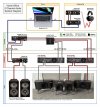Measuring roughly 10' square with an 8' ceiling, they say I have bad dimensions for getting good room response. Initially, that was definitely the case. It took some perseverance (and lots of room treatment), but I'm incredibly happy with the end result. My system's in room response now matches my target curve incredibly well in both channels from 20Hz-20kHz, and I've done sweeps up to 105 dB with no compression.
The setup is a nearfield desktop system using Revel M105s and four sealed 8" subwoofers that I made using Dayton Ulitmax drivers. Dual Crown amps provide 525w to each Ulitmax, which are running as stereo pairs, making each L/R channel individually full range. The processor is a miniDSP Flex running Dirac Live, with 2 channels going to a Topping PA5 for the Revels, and 2 channels going to a miniDSP 2x4HD to feed the Crowns/subs.
I'm using a 24dB/oct crossover at 80Hz, and then setting delays on each channel according to the measured distances to my ears. I use Tightly Focused Imaging in Dirac Live since the system is used at a desk, and I have my own target I use that I've added to the graphs.
I have to say, I am very impressed at just how tight Dirac was able to correct each channel!
 Before Calibration:
View attachment 282168
Dirac Live Calibrated:
View attachment 282169
Before Calibration:
View attachment 282168
Dirac Live Calibrated:
View attachment 282169
After how simple the final calibration process ended up being, I feel a bit foolish for how much I was overthinking things. I knew I had to set the XO and delays before running Dirac, and that I should put care into getting them right first. I measured the distances from the drivers to my ears, and set the delays all based on that. I took some initial REW sweeps before calibration, and I didn't like what I saw. Before even trying an initial calibration, I started fine tuning delays until each native response channel looked best to my eyes. Then I ran Dirac and did not get the results I was hoping for. I kept fine tuning and tweaking, moving onto the crossovers, but I was getting disappointing results in Dirac every time. I tried to use MSO to sort it out, and that also went poorly.
I was getting frustrated. By this time, I'd spent days monkeying around. I finally considered that I had never actually attempted to run Dirac with the initial delays that I had calculated based on distance, so why not at least see what Dirac can do with it. Well it turns out that the delays based on actual measurements nailed the best result. Go figure! I could have saved days of monkeying around!

Live and learn! At least I won in the end. It really does sound fantastic, and it's a joy to listen to this rig all day while I work from home.
System diagram is attached.








